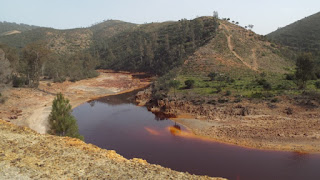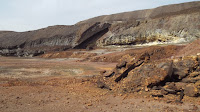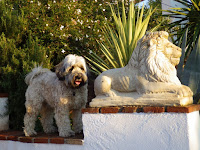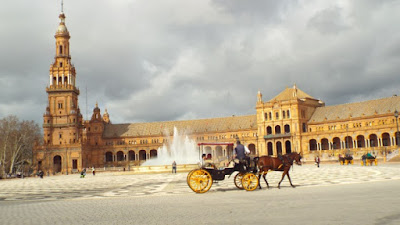 |
| Plaza de Espana - built for the 1929 Expo |
We have just completed another happy experience through HelpX with our wonderful host Sandie, able to check out the local town of San Luca an unremarkable town of a few thousand people which services a rural community, within
 |
| Our home at San Luca |
commuting distance to Seville a 40 min train ride away.
Sandie has an acre of rural living with a finca that has had some reno work done and a stand alone cottage, built when they first came here several years ago, which is where we stay. Sandie is a English tutor at an academy and is also studying a business degree so has limited time to do the section tidying required. She recently had trees dropped then roots pulled and we have spent our fortnight here burning roots, strimming long grass, tidying, in short odd jobbing and believe we have made a difference for Sandy. We also took Luna,
 |
Bill's first job -
get the hot water working |
|
the very placid golden lab, for walks around the local park (Verde Corridor) and neighbourhood.
We ventured into Seville via train twice, again trains cheap and regular. Seville is historic for many reasons and we were able to sample a small part of whats on offer here.
Cristóbal Colón (Christopher Columbus) is one of the characters that gets a lot of exposure here in Sevilla, though having just trawled through his life and times
 |
| CC's mortal remains (well some of them) |
he probably gets exposure in many cities. However his remains are buried here, well , there are some bones here, as elsewhere. One thing for sure was CC was responsible for instigating trade with the Americas, and here in Sevilla there is the Kings tobacco factory, for the King had sole rights to market tobacco throughout Europe for some time. Actually Spain in many ways was the Great Super Power of its time, a time when the UK was still very much in the dark ages.
 |
| Out the front of Plaza de Espana |
We walked around the city to get an idea of what we wanted to do next week when we would return. A cloudy overcast day, but able to wander in awe, visiting a few monuments including the Cathedral where said CC is said to have his remains, certainly some bits of him anyway.
We returned the following week, after waking to a real frost, the first we've experienced down here, followed by beautiful blue skies but a bitter wind.
We did a walking tour of many of the City's monuments with our guide Rafael, who spoke good English with humour, making the 3 hours of history very interesting and
 |
| Inside the Gothic Cathedral |
informative. This method of touching a cities history is great as have now done several walking tours of the cities we have visited. They are "Free" but are encouraged to make a donation commiserate with what you think is the value.
We liked Sevilla and believe it would be a truly memorable visit in summer, with its lovely parks and gardens, at this time of year looking a little tired awaiting some spring flush to leaf the place up. However we did enjoy, and though not likely to be back we can safely recommend it to any traveller who wants a place
 |
Metropol Parasol
Great views of Seville from the top |
that ticks most of the boxes.
Next day as the beautiful weather continued (no wind thankfully) we drove 40 mins further inland to the historic Roman city of Italica, founded in 206 BC as an important cultural place for the Romans along side the always bigger Sevilla. Two Roman Emperors Trajan & Hadrian were born at Italica and as a result when they duly became Emperors the city was much gifted from distant Rome. It boasted the 3rd biggest amphitheatre in the empire seating 25000 people, with a town of only 8000!! But as all things are inevitable, the shifting river, & siltation from deforestation,(yes even way back then) the nearby city
 |
| Italica's Amphitheatre |
of Sevilla rose in prominence with the need for commerce to stay in touch with said river, Italica slowly fell into disuse by about 200 AD, and by 400 AD largely forgotten except as a rich resource of stone and marble. The ignominy of it being the marble imported from Greece often being ground into limestone to be burned for cement.
Ironically one of the great saviours of what is now left, a Cisterian monk from the nearby Monastery in much later times, who did valuable work in recording historic locations etc. as we now have, but not before the monastery itself purloined some lovely marble columns and capitals to mount crucifix's on in the church
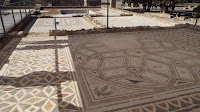 |
Mosaic Flooring
Amazingly intricate |
grounds.
Also made clear was the attempts through recent times the (1800's) by well known archaeologists who came and organised big private digs and cataloguing of valuable information but often purloining the most valuable sculptures and monuments gifting them to their own countries and into private collections. These days there is little digging going on as there is enough of the town dug up to keep all parties happy and huge areas mapped for future digs as expertise, funds, and interest dictate.
 |
Existing and unrevealed
ruins of Italica |
Italica's amphi theatre and mosaics in situ are amazing as is the theatre, sadly though this last sight is the other end of the now occupying village and its opening hours very curtailed, we were unable to visit that apart from looking through the security mesh.
We have been intrigued by the orange trees lining streets in many many areas, through out Spain and wondered why they weren't eaten as the streets are littered with the ripe fruit. Sandie exclaimed that they were Sevilla Oranges as if that explained all. So we picked a couple and they looked lovely,juicy, ripe but tasted like the sourest grapefruit you have ever tried. Suitable
 |
| Seville Orange Trees |
only for marmalade and with a real health warning if you're on any meds, beware. Sandie gave us some homemade marmalade and it was very nice, thank goodness for sugar.
An interesting Solar Installation was about a Km up the road from us which was the first thing we saw as we arrived here. It is a parabolic reflector array and sunlight is focused from over a thousand of mirrors tracking the sun , focusing the light into towers that have a liquid that is super heated, driving turbines to generate
 |
| The solar installation up the road |
substantial amounts of power. The company Abengoa has two of these and photovoltaic cells at this location producing up to 300 megawatts on a good day. impressive to say the least. Until 2014 this was the largest plant in the world, however the USA now boasting a bigger plant. We were able to wander up to the security fence, as the mirrors tracked the sun, hearing the mirrors creak as they hydraulically shifted every few minutes. The towers could be seen for many Km's and were an unearthly sight with light being shone up from the ground mirrors
 |
Light receiving tower in action
With camera filter on full |
and the glowing iridescent towers capturing this light, quite surreal
We stayed on with Sandie finishing some tasks with our planned departure on the following Monday. We enjoyed a lovely BBQ there with some of Sandie's colleague's from the English Language Academy, mostly British Expats teaching the Spanish, there being a strong demand for English, so necessary in the world of business.
 |
Bill & Luna out for a ride/walk
along the Verde Corridor
|
We are moving into Portugal by the end of the week after a few days on a lovely Atlantic beach.
More to come...........






